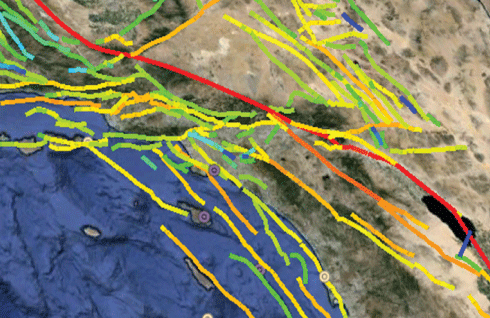If the tragic hurricanes weren’t enough, now Mexico has been struck by a 8.2 earthquake last night. I covered earthquakes in San Diego last month, but here is another story on the risk of the Big One hitting Southern California – and San Diego is still looking good, relatively:
The U.S. Geological Survey 2014 earthquake forecast indicates that the likelihood of a moderate earthquake – between magnitude 6.5 and 7.5 – has decreased, but the chance of a higher-magnitude quake in the region has increased.
Plate movement
The rate of plate movement along the San Andreas fault is approximately 1.3 inches each year – about the same rate your fingernails grow. A USGS report released March 2 detailed a study of the southern San Andreas fault. The study found evidence of 10 ground-rupturing earthquakes between magnitude 7.0 and 7.5 between 800 A.D. and 1857.
Predictions based on the survey forecast a 16 percent chance of a magnitude 7.5 or larger earthquake near Kern County in the next 30 years.
Prediction models
The USGS cautions that although its most recent prediction model is vastly improved since the version in 2008, it is still an approximation. The USGS uses two kinds of scientific models to predict earthquake probability.
1. The earthquake rupture forecast shows where and when the earth might slip along the state’s many faults.
2. The ground motion prediction model estimates the subsequent shaking given by one of the fault ruptures.
The color-coded data are the state’s forecast from 2014:
(SD in bottom right corner)

The USGS estimates long-term quake hazards to give communities an assessment of risk in their area. More than two-thirds of the nation’s annualized earthquake losses in property and structures will be in California, and in California, 80 percent of the losses will be in these 10 counties:
Top 10 counties by estimated annualized earthquake loss (percent of state total)
1. Los Angeles (30.6%)
2. Santa Clara (8.9%)
3. Alameda (8%)
4. Orange (7%)
5. San Bernardino (6%)
6. Riverside (5.6%)
7. Contra Costa (4.6%)
8. San Francisco (3.8%)
9. San Mateo (3.5%)
10. San Diego (3.3%)
A major earthquake hitting Southern California would be devastating to the region, and is one of the biggest threats to disrupting the housing market. But hopefully the impact on San Diego housing would be less.




Some old style buildings owners are being ordered to retrofit by the city, and the owners have to absorb most of the unexpected costs, which creates a lot of foot dragging and overall delays. Meantime, if an earthquake hits before then, the losses will be incurred by everyone in the aftermath with more lost housing.
Meanwhile the city hands over many, many millions every year for personal pet projects of various council members, the federal government upchucks hundreds of millions in false HUD claims, and the like, while not giving a break to the property owners just squeaking by, trying to take on a load of retrofit debt they had no idea they would be taking on when they bought the property.
Institutional property owners can figure out a way to juggle the debt, but mom and pop property owners get the shaft. They have to dump properties they don’t want to sell at a significant discount through no fault of their own.
Our government sees fit to “help out” corporations, and certainly to “help out” the poor, but the middle-class pays every cent.
The more negligible the middle-class becomes, the more negligible the overall quality of life becomes for everyone. Anyone who remembers California in 1970 to now can see this isn’t a theory.
It’s a fact.
Meantime, we have a billionaire boy king, who has more personal information of the population than the CIA, who professes to love Roman history like a Trekkie loves every incarnation of Star trek, and even cuts his hair in a style reminiscent of Caligula. Nobody in the media is taking notice. Nobody is breaching the subject that there may be a better than even chance that this boy king may be a little mad. “He’s wildly successful. He can’t be crazy,” they say, while they continue to detect Nazi’s behind every bus bench in North Carolina.
Besides, we may have an earthquake one day. It’s time to retrofit your house, at your expense, grandma. Or sell it to Xing Pow Property Management Corporation. They can afford it, if you can’t. Earthquakes a-comin’, according to earthquake/excel spreadsheet experts.
This is America. In America, we make decisions.
Make a decision, grandma.
http://www.latimes.com/local/lanow/la-me-ln-california-mexico-earthquake-20170908-htmlstory.html
Here’s what could happen if it struck at 10 a.m. on a dry, calm Thursday in November, based on an earlier interview with Jones and according to the ShakeOut report:
The death toll could be one of the worst for a natural disaster in U.S. history: nearly 1,800, about the same number of people killed in Hurricane Katrina.
More than 900 could die from fire; more than 400 from the collapse of vulnerable steel-frame buildings; more than 250 from other building damage; and more than 150 from transportation accidents, such as car crashes due to stoplights being out or broken bridges.
Los Angeles County could suffer the highest death toll, more than 1,000; followed by Orange County, with more than 350 dead; San Bernardino County, with more than 250 dead; and Riverside County, with more than 70 dead. Nearly 50,000 could be injured.